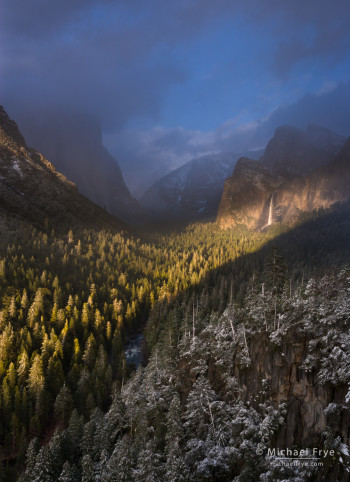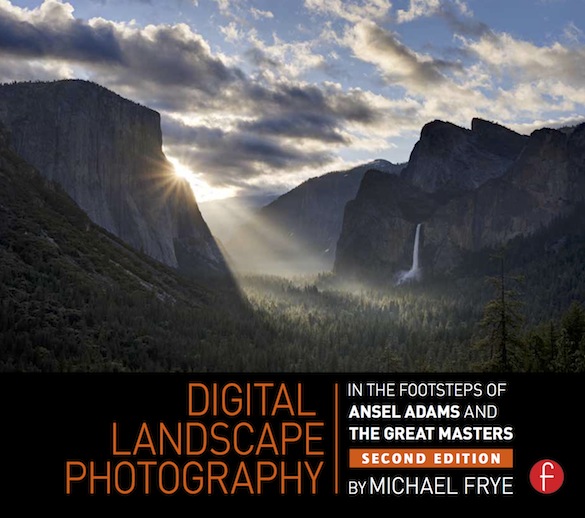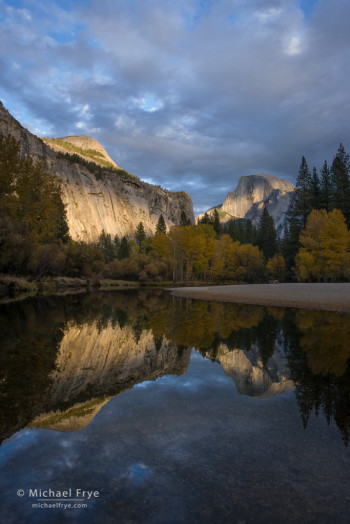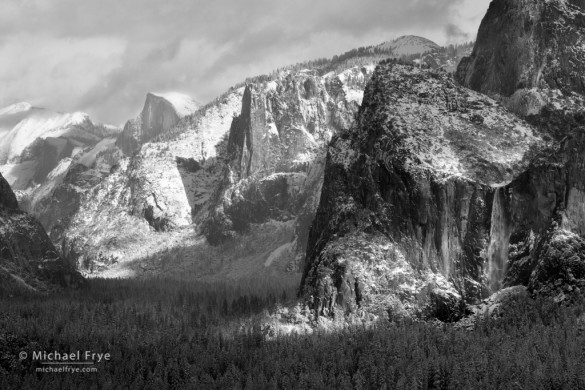In the Moment:
Michael Frye's Landscape Photography Blog
by Michael Frye | Feb 21, 2016 | Digital Darkroom, Vision and Creativity

Beam of light striking Bridalveil Fall, Yosemite NP, CA, USA
“The term visualization refers to the entire emotional-mental process of creating a photograph, and as such, it is one of the most important concepts in photography.”
— Ansel Adams
I’ve become increasingly aware of the power of visualization over the years. Looking back through my own work, it’s clear that my best photographs were created when I had a strong response to a subject or scene, knew the feeling I wanted to convey, and was able to visualize in advance how I wanted the finished image to look.
But what does visualization mean, and how does it apply to digital photography today? Although Adams mostly talked about visualization in relation to technique, he also made it clear that visualization was part of the creative process. He wrote: “Visualization is a conscious process of projecting the final photographic image in the mind before taking the first steps in actually photographing the subject. Not only do we relate to the subject itself, but we become aware of the its potential as an expressive image.”
(more…)
by Michael Frye | Dec 8, 2015 | Announcements
Thanks to all of you who bought the new second edition of Digital Landscape Photography, either directly from us, or through Amazon. I really appreciate all the support! We have sold out of the limited number of copies we had on hand, but we will be getting more, and I’ll let you know when we do. In the meantime you can get the book from Amazon, although of course it won’t be signed.
Thanks again!
— Michael Frye
by Michael Frye | Dec 8, 2015 | Announcements

Ilex Press and Focal Press have just released the second edition of my book Digital Landscape Photography: In the Footsteps of Ansel Adams and the Great Masters.
This book looks at the techniques of past masters of landscape photography – particularly Eliot Porter, Edward Weston, and Ansel Adams – and explores how those techniques can be adapted to digital photography today. In this new edition, I tried to infuse the book with even more of the master’s words, ideas, and images. I was happy to also be able to include images by Minor White and Philip Hyde, in addition to photographs by Adams, Porter, and Weston. I was also able to interview people like John Sexton and Charles Cramer who knew Ansel and his techniques, or had, I thought, particular insights into how traditional film and darkroom techniques relate to modern digital photography.
(more…)
by Michael Frye | Nov 19, 2013 | Composition, Photography Tips, Vision and Creativity

Half Dome and the Merced River, 4:28 p.m.
Is it better to be active or static? To change your location and composition to suit the light, or hope that the light changes to suit your composition?
There’s this persistent myth that Ansel Adams would camp for days at one spot, waiting for the right light. Ironically, this myth is often repeated in relation to Clearing Winter Storm, which was made at Tunnel View, only a few miles from his warm home and comfortable bed in Yosemite Valley. In fact Ansel wrote, “I have always been mindful of Edward Weston’s remark, ‘If I wait for something here I may lose something better over there.’ I have found that keeping on the move is generally more rewarding.”
I have also found that keeping on the move is more rewarding. I’ve sometimes regretted moving, but more often regretted staying when I ignored the inner voice that told me the light would be better elsewhere. And when I do find myself in the right place at the right time, I’ve found that it pays to stay active with my camera and my compositions, and not get lazy about changing lenses or camera positions. If I decide in advance what my composition should be, and stick with that no matter what, I’ll probably miss some great opportunities.
(more…)
by Michael Frye | Sep 17, 2013 | Announcements

Half Dome, Sentinel Rock, and Bridalveil Fall after a snowstorm, Yosemite NP, February 9th, 2009
Clearing Winter Storm is my favorite Ansel Adams photograph. To me it captures the majesty and grandeur of Yosemite Valley like no other image.
(I wish I could show the photograph here, but I’d violate copyright laws in doing so. You can click this link to see Clearing Winter Storm. The image shown here is one of mine that was made on February 9th, 2009.)
The funny thing is, no one knows when this famous image was made. Ansel had a notoriously bad memory for dates, and various years have been given by him and others for this photograph, ranging from 1935 to 1944. In his book Examples, Ansel wrote that the image “came about on an early December day,” but again, his memory was not particularly reliable about such things.
A couple of years ago, Don Olson contacted me about dating this photograph. Don is a Professor of Physics and Astronomy at Texas State University, and he and his colleagues have used the position of the moon to find the precise date and time that Ansel captured two images: Moon and Half Dome, and Autumn Moon, the High Sierra From Glacier Point.
(more…)












